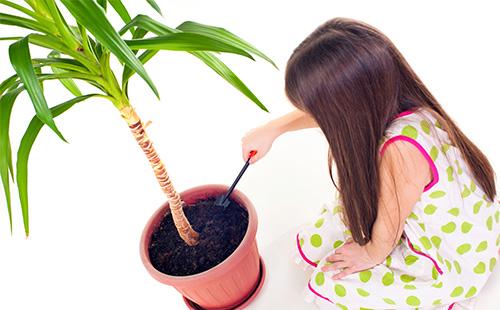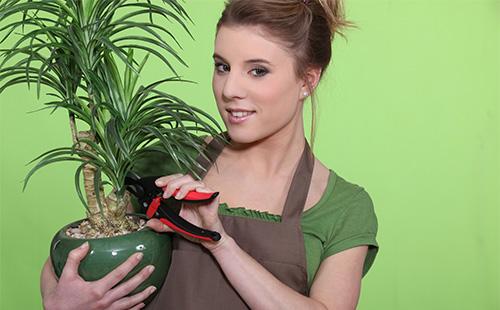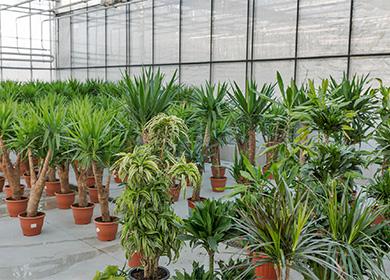The content of the article
The homeland of a perennial perennial plant is arid tropical areas. In common people, a yucca is often called a palm tree, although it is not one. The plant of the Agave family is divided into two genera: stemless and tree-like. In nature, it reaches a height of over 10 m, at home - no more than 2 m.
Plant species
The yucca plant has about 40 species that differ in appearance. The most common indoor - aloe and elephant, it is also "giant."
- Aloeelist (Yucca aloifolia). It has a straight trunk with sharp dark green wedge-shaped leaves, which are covered on the edges with small cloves. Outwardly resembles a tree with a spherical crown. Under natural favorable conditions, grows up to 8 m, the length of the leaves can reach 55 cm, and the stem diameter is 10-13 cm. When grown indoors, the maximum height is 1.5 m. During flowering, throws a long vertical arrow on which white funnel-shaped flowers appear . As they grow older, the leaves gradually turn yellow, sag to the ground and fall off. It will most effectively look in a warm spacious room with good lighting.
- Elephant (Yucca elephantipes). The plant got its name due to the characteristic shape and size of the trunk of an adult tree - a straight trunk with a thickening at the base resembles an elephant's foot. In nature, the maximum height of the plant varies from 7 to 9 m, and the width of the root base is up to 4 m. At home, it grows slowly, reaching a height of no more than 2 m. In the upper part, the trunk diverges into several straight shoots, the tops of which have dense deciduous power outlet. The leaf plate of light green color with serrated edges reaches a length of over 1 m. Once a year, mainly in the summer, the elephant yucca releases large peduncles in the form of white bells, collected in panicle inflorescences.
- Filamentous (Yucca filamentosa). It has several varieties, some practically have no stems and grow horizontally on the ground, thanks to a powerful root system. They are often planted in the garden, although some specimens are suitable for cultivation in greenhouses or cool, spacious rooms. The plant is resistant to frost. Spiky green leaves grow in length over 50 cm. The edge of the leaf plate is divided into thin fibers - this is where the name of the species comes from. The peduncle is a large panicle with cream or white flowers.
- Sisaya (Yucca glauca). The spectacular appearance resembles a dracaena or a small palm tree. A strong, tree-like trunk is crowned with a thick rosette of narrow leaves with a bluish-green color with a light edge that reach a length of about 60-70 cm. Curly thin gray threads are noticeable at the edges of the leaves.Perennials can be planted in open ground in gardens with a warm climate, and it is also possible to grow yucca at home: in bright halls, spacious living rooms.
- Glorious (Yucca gloriosa). It resembles a spherical bush in shape. At a young age it does not have stems, in mature - a strong single trunk appears. Oblong dark green leaves are very densely arranged, which makes the crown quite lush. The leaf length grows within 0.5-1 m, and the inflorescence panicle in the center of the crown reaches a height of 1.5 m.
Yucca Home Care
Regardless of the type, caring for a yucca after a purchase does not require much time. In a home environment, she will feel more comfortable if conditions are organized that are close to the native natural climate of a tropical plant.
Location and Lighting
The photophilous flower should be placed in the sunniest places of the room - near windows facing the east or south sides. Daylight hours for a plant - at least 16 hours. In summer it is recommended to take the flower to fresh air: a street or a balcony, and in winter to provide artificial lighting.
It is necessary to regularly ventilate the room in which the exotic mini-tree lives, but drafts should not be allowed - the yucca does not tolerate them and may, after a while, drop the leaves. A long stay of the plant in a damp and dark room will lead to wilting.
Temperature and humidity
In the summer and off-season for home yucca, the permissible temperature is from 20 to 25 ° C, in the winter season - 15-19 ° C. Do not lower the level below 8 ° C - this will slow down the growth of the flower. With a sharp temperature difference, the leaves may turn yellow, and in a hot room and with a lack of light, they may become thinner, lose their bright color and elasticity.
The degree of humidity for yucca is not critical, however, dry air is more acceptable. An exception will be rare moisture-loving varieties, for which spraying is necessary in the warm season, and in the winter installation of a pallet with water or wet gravel.
Watering Rules
Often you do not need to water the yucca, it is enough to maintain the soil moderately moist, but not to allow drying out. In summer, one watering in seven days is enough, in winter - in 10-12 days. Florists recommend orienting themselves on the following basis: if the soil has dried out by 5-6 cm in the pot, then it is time to moisten it.
Water should be used purified or settled for at least seven days in a ratio of 5: 1, that is, 1 liter of water should be used on 5 liters of land. Darkening of the tips of the leaves indicates an excess of water in the soil, which in the future can provoke decay of the root and lower stem.
Top dressing
During the period of intensive growth, from the beginning of April to the end of August, one or two times a month you can feed indoor yucca with non-concentrated mineral fertilizer. The concentration should be one and a half to two times lower than indicated on the label.
Organics are also suitable - an infusion of cow or horse manure, as well as deciduous humus. Judging by the reviews of flower growers, foliar fertilizing gives a good result - spraying the inside of the leaves with diluted mineral fertilizer.

Timely trimming
Proper pruning provokes the appearance of several young shoots, from which lush leafy rosettes are subsequently formed. The procedure should be carried out in March. It is advisable to trim the home yucca by backing at least 50 cm from the base of the barrel with a clean pruner or knife. It is necessary to cut the trunk with one sharp movement, it is impossible to break it - this will lead to a long illness and even death of the tree. The slice should be sprinkled with crushed charcoal or paraffin so that the plant does not lose internal moisture.
After trimming, the yucca is placed in a penumbra room. After two to three months, new processes will begin to appear around the cut site.
Transplant: primary, regular
The first time you need to transplant a yucca at home in another pot immediately after purchase, then make a regular transplant in late March or early April: a young flower - every year, at the age of five years - once every two to three years. To properly plant a yucca, follow these five guidelines.
- Pot. Choose clay or ceramic with several holes on the bottom for draining water - in this soil dries evenly, which eliminates root decay. Rhizome should be located in a pot at a distance of 2-3 cm from the walls.
- Earth mixture. Use the peat mix from the store or cook it yourself by mixing two norms of turf soil and sand with one norm of humus.
- Drainage. At the bottom of the pot, place a drainage layer about 4 cm thick, on top of which lay a 2-3 cm thick soil mixture.
- Disembarkation. Plant the yucca in the prepared pot along with the old soil so as not to damage the roots, fill the remaining space with fresh soil.
- Watering. There are some nuances in how to care for a yucca after a transplant. Water the plant moderately for a month and a half, placing in a room with uniform illumination.
Reproduction: 4 ways
There are several proven methods for breeding yucca. Compliance with simple rules will help to grow a healthy plant.
Seeds
Features To get guaranteed plant shoots, you should choose quality fresh seeds in the store. At home, gather seeds only after artificial pollination. The landing procedure is as follows.
Breeding process
- Soak the seeds for a day in clean water.
- Plant in a pre-prepared soil mixture of sheet and turf soil and sand to a depth that is equal to the diameter of three seeds.
- Cover the soil with a translucent film or a sheet of glass and spot it in a warm place with good sunlight, maintaining a constant humidity of the earth.
- Ventilate twice a day, wipe the film or glass from condensation.
- The first shoots will appear after about four weeks.
- When the sprouts release the first two leaves - dive and transplant into a separate cup or small pot.
- After ten days, make the first fertilizing with mineral fertilizer.
- After the formation of the first five leaves, the plant is considered an adult and is ready for normal care.
Cuttings: stem and apical
Features The rooting procedure of yucca with cuttings should be carried out in warm time, preferably in the spring, so the cuttings will take root more quickly and take root. The apical form only roots, and stem additionally shoots from the buds of the kidneys. Here's how to propagate a yucca with cuttings at home.
Breeding process
- Make a smooth cut of the cuttings 10-20 cm in size.
- Dry the slices for several hours, then treat with a special stimulant for root formation. The apical can first be rooted in water, then planted in a substrate, stem - immediately in the substrate.
- For the substrate, a mixture of sand and peat (1: 1) is used or a special ready-made soil is purchased.
- Deepen the stem into the ground vertically by about 3 cm and fix it well.
- Moisten the substrate regularly, control the temperature within 20-25 ° C. To maintain the required humidity, cover the cuttings with glass jars or a film; you can choose the method of regular spraying.
- Once the cuttings are strong, plant in flower pots.
Parts of the trunk
Features From a large plant, you can make several copies. It is necessary to propagate yucca in this way in early spring.
Breeding process
- Carefully cut the top of the tree with a sharp knife, treat the sections with activated charcoal and dry for several hours.
- Place the trunk in purified water, as soon as the roots appear - transplant into the ground.
- If the part of the bare trunk is too large - place it horizontally in a box with wet sand, deepening by one third.
- When the buds on the trunk release shoots with roots, carefully separate them and plant them in separate pots.

Adnexal roots
The easiest type of reproduction, which is often used for stemless plant species. In the warm season, the root offspring should be carefully separated with a sharp knife blade from the main root and rooted in containers with wet sand.
Flower disease
Homemade yucca is not capricious and with proper care it is extremely rare. However, improper containment conditions can cause plant malfunctions. How to determine the cause by visible symptoms can be found in the table.
Table - Yucca diseases and pests, plant resuscitation
| Symptoms | Cause | Treatment |
|---|---|---|
| Leaves turn yellow | - Natural age process (leaves live about two years, after they turn yellow and gradually die off) | |
| The leaves are dry | - dry air; - insufficient watering; - drafts | - Increase the humidity in the room; - spraying; - regular soil moisture |
| Leaves fall | - Subcooling; - drafts; - excessive watering | - Creation of favorable conditions; - good lighting; - reduced irrigation regularity |
| Leaves twist | - Sudden subcooling | - Temperature control |
| The appearance of bright spots | - Excessive amount of light; - direct sunlight | - Compliance with the light mode |
| Dark spots | - Defeat with a fungus; - excess moisture | - Removing damaged leaves; - spraying with fungicide; - reduction of watering |
| Pale elongated leaves, shoots | - Not enough light; - heat | - Compliance with light and temperature conditions |
| The appearance of spider mites, aphids, caterpillars and other pests | - Wrong excess watering | - Treatment with systemic insecticides; - use of immunomodulators |
How to care for a yucca so that it blooms is a frequent question for beginner gardeners. The fact is that the plant blooms only in its natural habitat. It is pollinated by a small butterfly - Pronuba yuccasella moth, which does not live in our area. However, experienced gardeners argue that the flowering of some types of yucca in the home content can be achieved by going to a little trick. Let the plant overwinter on a well-insulated balcony - the emergence of flower buds is possible during a long stay in the cold, but not earlier than three to five years after planting.
Reviews and experience of gardeners
Yucca is a very unpretentious plant, and like all unpretentious plants, it is afraid of "overcrowding." During all this dry summer I watered only twice, and it seems to her like that just right.
Andrew, http://bezlji.com/yukka-nitchataya/
Neither hassle nor worries! No vagaries on her part.The only moment: loves bright lighting.
YKK, http://bebi.lv/uhod-v-domashnih-usloviyah/yukka-foto-vidov.html
The fourth year grows from a yucca seed filamentous in a pot. I take it out to the yard for the summer, to the sun. I'm afraid to land on a permanent place in the garden. In our area, winter has changed over the past decade and it is unlikely that you will be able to save yucca. In the spring I would venture to separate the roots for insurance and determine the uterine bush for residence, there is a suitable place for this. I don’t water it especially in winter, I feed it in December and February with Urgasoy (em powder) or SLOX for root dressing. Both remedies are good for all types of flowers, and for all vegetation.
Marina, http://www.glav-dacha.ru/yukka-sadovaya-posadka-i-uhod/
They told me that there are unpretentious house flowers. But that they may be undemanding SO, I did not even suspect until I met Yucca! I have a bright apartment, but the air is very dry, especially during the heating season. In addition, I often leave for my elderly parents to the region, and my yucca has been left without watering for more than a week. Under all these adverse conditions, she pleases me with a wonderful condition and a very fresh appearance. It seems to me that with the advent of yucca in my house, living in it became more pleasant, as if the atmosphere had changed for the better. I am very pleased!
Irina Veniaminovna, http://florito.ru/index.php?ukey=product&productID=576804

